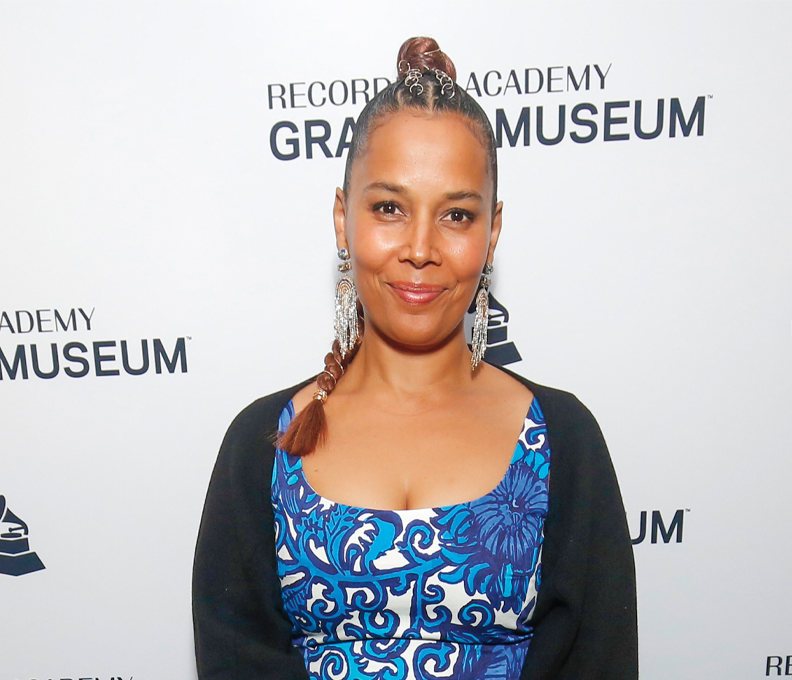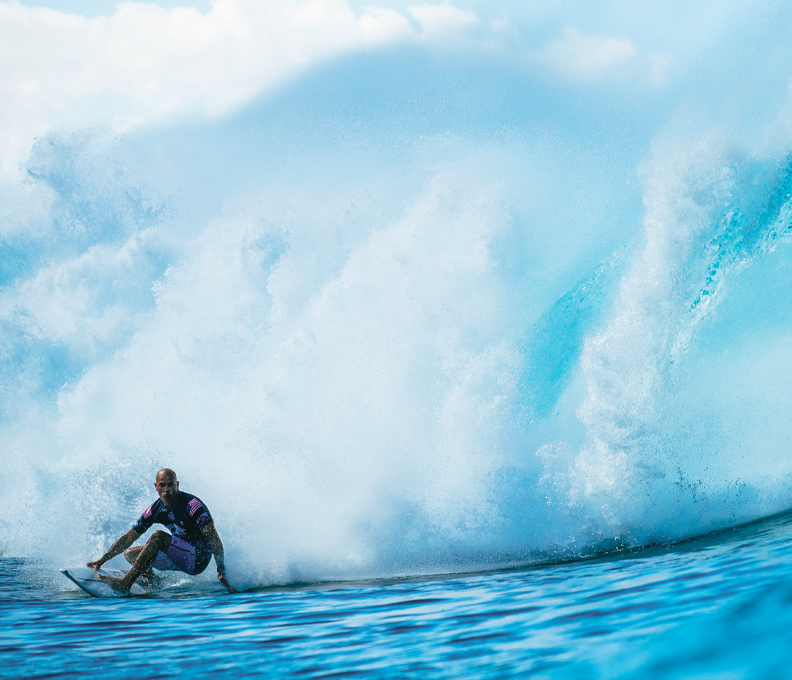Meet Kerry Reeves: The Man Behind Air New Zealand’s Award-Winning SkyNest
From introducing bunk beds in Economy Class to pioneering the Skycouch and designing new Business Class seats, Reeves has transformed the airline’s passenger experience
June 26, 2023

Photo: Kerry Reeves. Courtesy of Andreas Spaeth.
Six bunk beds for Economy Class passengers to lie down in shifts on ultra-long-haul flights is what Skynest will offer Air New Zealand passengers on flights from Auckland to New York and Chicago from September 2024.
Starting in September 2024, passengers flying from Auckland to New York and Chicago will have access to six bunk beds to lie down in shifts during their journey. This groundbreaking concept—never attempted before—showcases Air New Zealand’s commitment to enhancing passenger comfort and positions itself as one of the industry’s most innovative airlines.

Photo: Boeing 787-9 Dreamliner. Courtesy of Air New Zealand.
With the unique challenge of being far from other major centers worldwide, New Zealand has embraced the “tyranny of distance,” as locals call it Down Under.
Although a relatively small intercontinental airline, Air New Zealand strives to provide unique solutions that cater to the needs of its passengers.
Kerry Reeves, who joined Air New Zealand at 18 in 1975, has been instrumental in driving multiple innovations for the airline. He now leads a team of 10 program managers and industrial designers, working out of warehouses in downtown Auckland. His expertise has made him the go-to product guru for the airline.
In the process of developing a new product, they are working diligently behind the scenes to create multiple mock-ups. Reeves told Business Traveler at the Aircraft Interiors Expo (AIX) in Hamburg that they handle all the design work in-house and do not rely on external agencies like other airlines do.
Skycouch for the Win
One of his most successful creations is the Skycouch, which was introduced by Air New Zealand in 2011. The Skycouch features three Economy Class seats that can be transformed into a bed-like space, making it a popular choice for families.
Other airlines, such as China Airlines, Azul from Brazil, and ANA on their A380s to Hawaii, have also introduced the Skycouch under a license from Air New Zealand.

Photo: SkyCouch. Courtesy of Air New Zealand
“Licensing is very lucrative for us,” reveals Reeves. “Most airlines see product design only as a cost factor, but we turned it into a revenue opportunity as a bonus.”
Reeves and his team’s innovations were not always well-received by customers, especially the Spaceseat Premium Economy seat introduced in 2010. Passengers expressed discontent about the limited legroom, and adjustments had to be made.
“The first generation of Spaceseats was also quite crude in the way it worked in its mechanism,” admits Reeves. “The Asian market didn’t value it; they wouldn’t pay a premium for that extra space. It finally came off our Boeing 777 aircraft in 2017.”
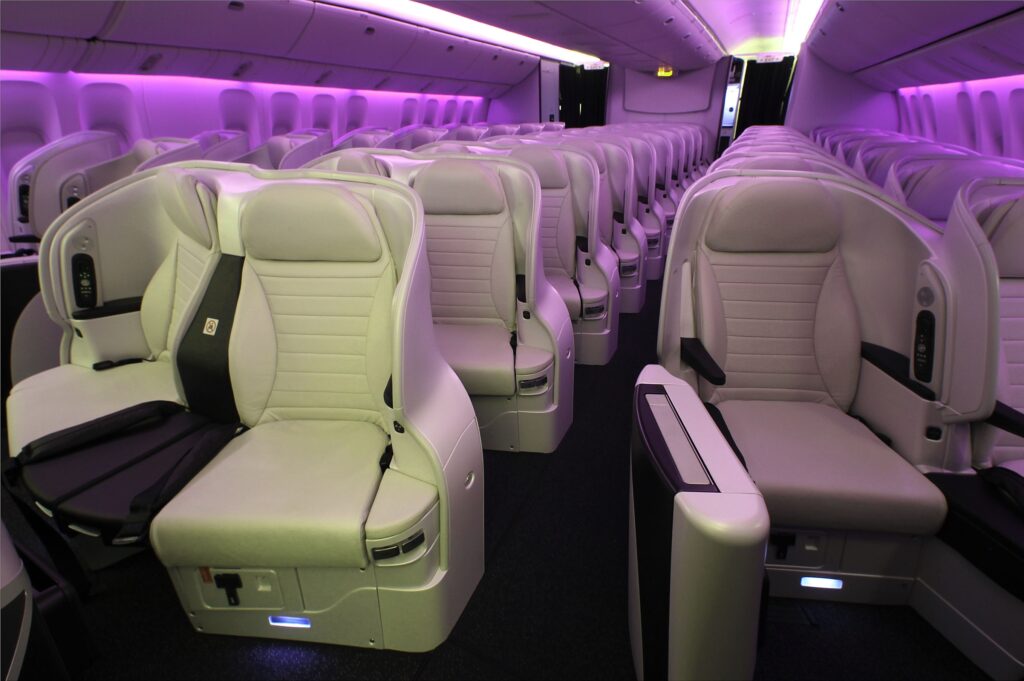
Photo: Spaceseat Premium Economy Seat (phased out). Courtesy of Air New Zealand
Even though the Spaceseat was not successful, it still taught the product development team in Auckland valuable lessons. “Don’t make things too complicated” was the main takeaway, according to Reeves. “Keep the features you are developing as simple as you can.”
“We learned that sometimes we made it too complicated for the passenger to understand how to use the Spaceseat’s features and too difficult for the crew to operate the aircraft with the complexity of the product,” he explains.
The Next Big Thing
In 2018, Reeves and his team moved into a new hangar in Auckland to breed on the next big thing. “For the first 18 months, we did customer research and built crude mock-ups. We had the experience of last time and knew how to do things much smarter and in much more depth.”
The customer’s message was straightforward and unsurprising: they want to sleep better while flying in Economy Class.
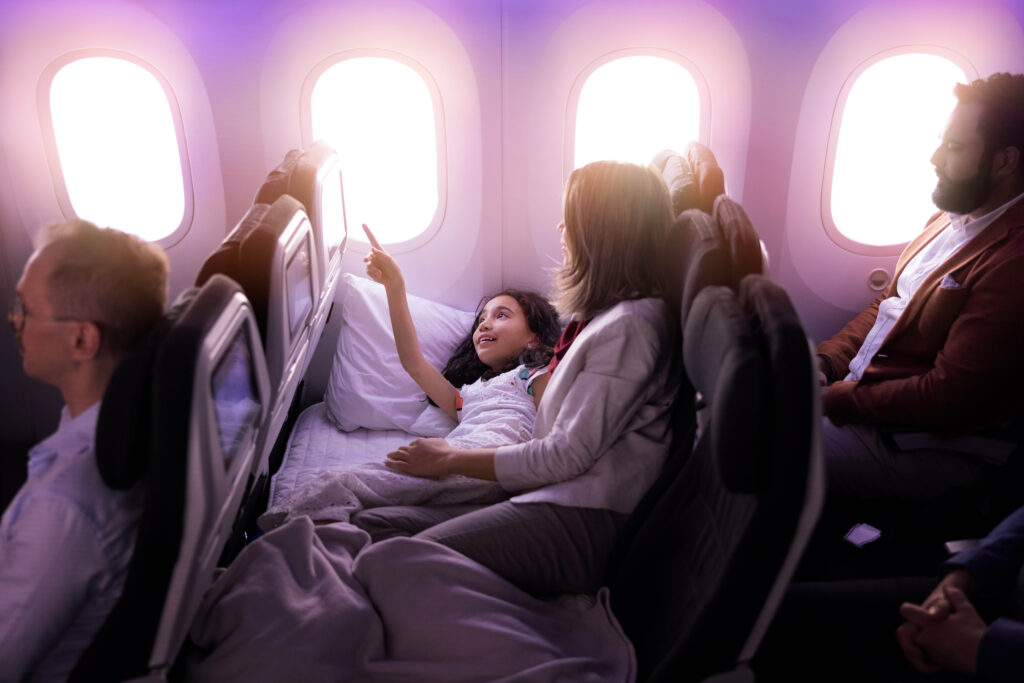
Photo: SkyCouch. Courtesy of Air New Zealand
“But other than for Skycouch, we just couldn’t solve the question of commercial viability for bunks in the economy. So, we had to park the idea and come back,” recalls Reeves.
After some long and hard thought, Skynest was announced in 2020: A box 82″ long and 50″ wide, installed in the center of the Boeing 787-9 Dreamliner, just behind the wings near the number three doors. It contains six bunk beds, measuring 80″ (203 cm) in length and 58.4cm (23″) in width, that customers will be able to book for four-hour lie-flat snoozing shifts.
“Seems easy, right?” Not really, according to Reeves. “Skynest is the most difficult and most challenging project of my career by a long way,” he reveals. It’s not the hardware of the bunk bed compartment.
“The hard part is installing it in the aircraft,” he reveals. “We discovered that the systems you have to have in there are so complex you wouldn’t believe it.”
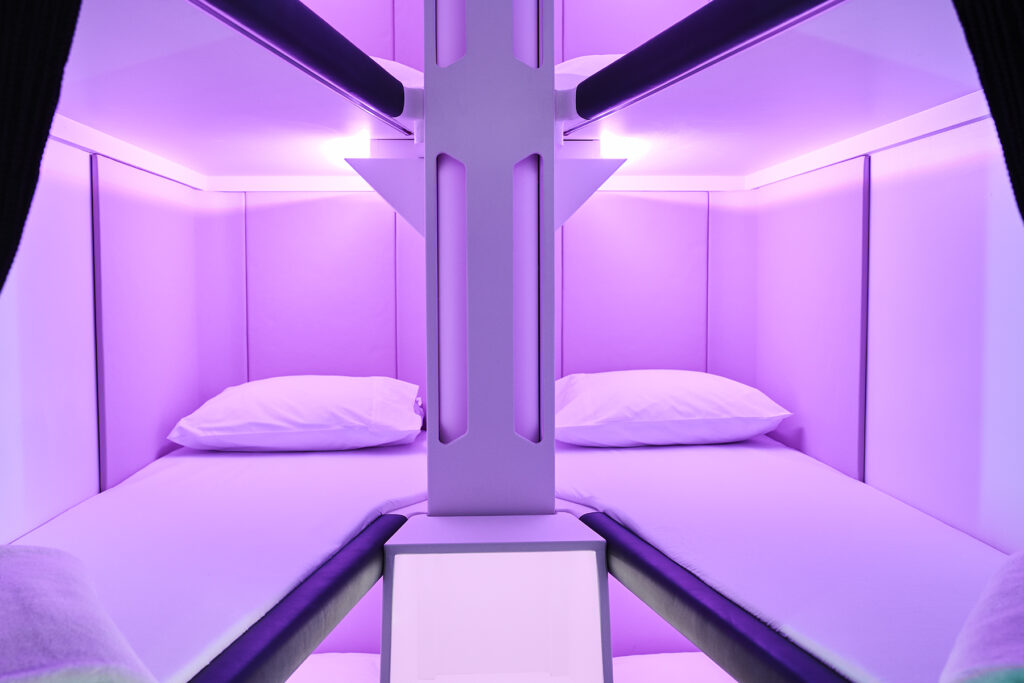
Photo: Courtesy of Air New Zealand
According to Reeves, his team found that oxygen lines, air vents, reading lights, emergency lights, fasten seat belt signs and seat belts are all to consider carefully. “Smoke detectors have to be installed in every bunk, too,” he remarks.
“The box becomes a cabin within a cabin. Even more complex is the commercial viability of the box—how to create value for the customer and the airline.”
The team had to think a lot before finding a solution to sacrifice only five Economy Class seats for Skynest instead of the nine required originally.
SkyNest to the U.S. in 2024
Initially, the bunk beds will only be available on two recently acquired Boeing 787-9 planes in September and October 2024. These planes have been designed explicitly with a premium-heavy layout and will have 219 seats—fewer than the 302 seats available on other Air New Zealand 787s.
“We will put it on the flights to New York and Chicago and see how it goes on these 17.5 hours flight time sectors,” he said.
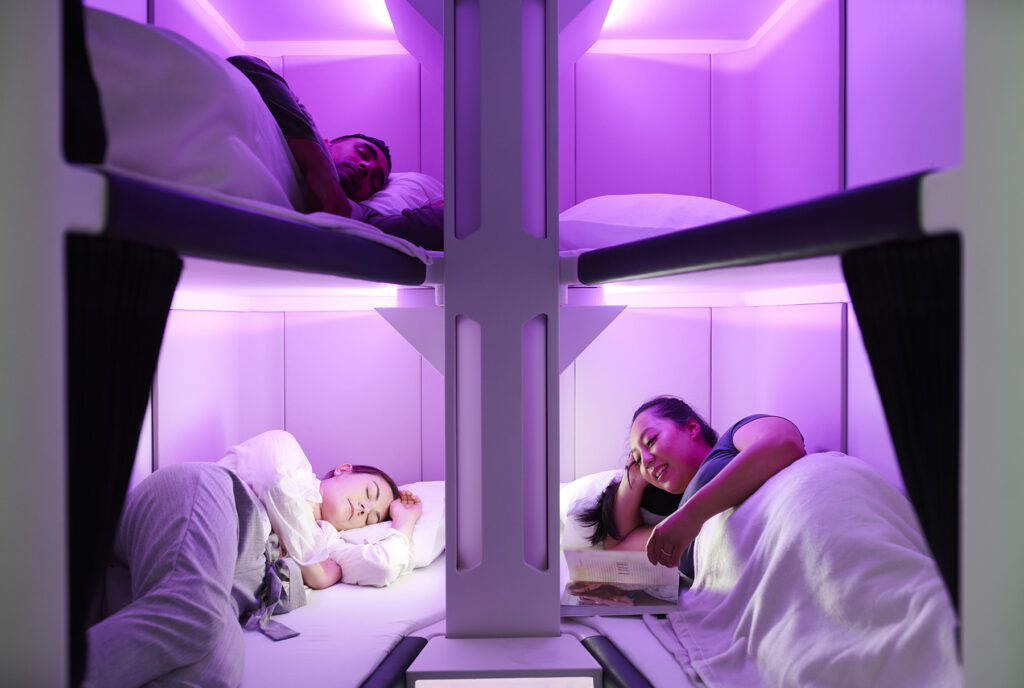
Photo: Courtesy of Air New Zealand
Long-enough flights seem to be essential for Skynest to succeed. “Sleep researchers told us that you can get a really solid deep sleep in four hours with two REM cycles,” Reeves says. “And we did customer testing and asked what they would pay for each hour, and after four hours, the value they saw started to drop off,” reports Reeves. “So four-hour sessions are optimal from a risk perspective and value proposition.”
A session should last for at least 3.5 hours to be considered feasible. This means that routes such as Auckland to Perth or Honolulu typically take eight hours and are unsuitable.
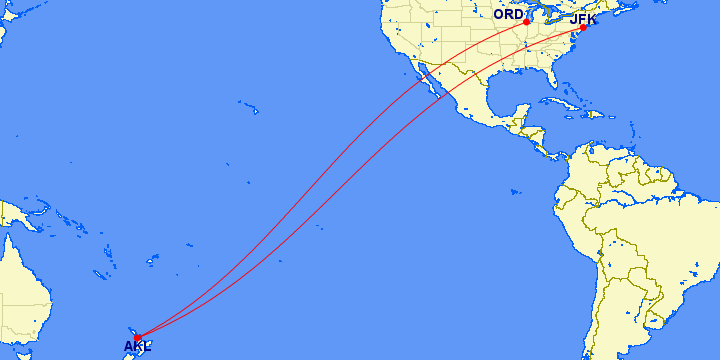
Photo: Air New Zealand’s ultra-long-haul routes from Auckland to New York-JFK and Chicago-O’Hare. Courtesy of GCMap
“On the ultra-long flights, we will offer three sessions, as we still want to have a buffer for turbulence and meal service,” explains Reeves.
“In turbulence, people can stay inside but might not be able to move out longer than planned. In between each session, we plan for about 30 minutes for the crew to clean and refresh and put new linen in for the next people to go in. Each new group of passengers using it needs to have an individual briefing on safety each time.”
How Much Will It Cost?
Even though the team has done the calculations multiple times, there is still a lack of certainty regarding how passengers will react to the new service. Reeves announces they are considering a charge of NZ$ 450-600 (US$ 280-370) for four hours, which they believe is reasonably priced and adds about a third of the average Economy fare.
“If we have any free bunks, you can still get them on board for the same fee,” he says.
Booking an Economy Class ticket plus a session in Skynest will still be cheaper at only a third to half added to the basic fare than traveling in Premium Economy, which is double the Economy fare. Passengers in Premium Economy will be offered access to Skynest at the same fee.
Winning Before Launch
At AIX in Hamburg, Air New Zealand won the prestigious Crystal Cabin Award for its Skynest concept. “We are doing this for all of the industry and want to improve its offering, not just for us,” Reeves told the audience in his acceptance speech.
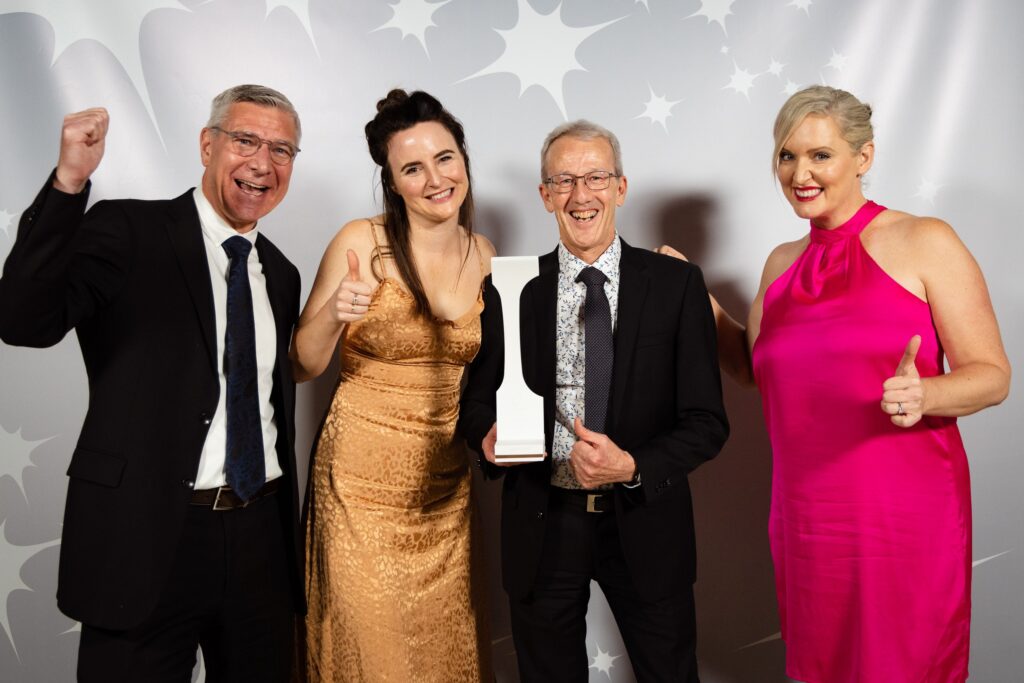
Photo: Air New Zealand wins the Crystal Cabin Cabin Concept Award 2023. Courtesy of Crystal Cabin Awards.
While Skynest was all the rave at AIX, the show also offered an opportunity to try out the new Air New Zealand Business Class seats based on the Visa model by French manufacturer Safran. Next year, they will enter service with the two new 787s on the New York and Chicago routes.
The good news is the new product finally does away with the current Business Class of the Kiwi airline, where feet face the aisles dreaded by many passengers.
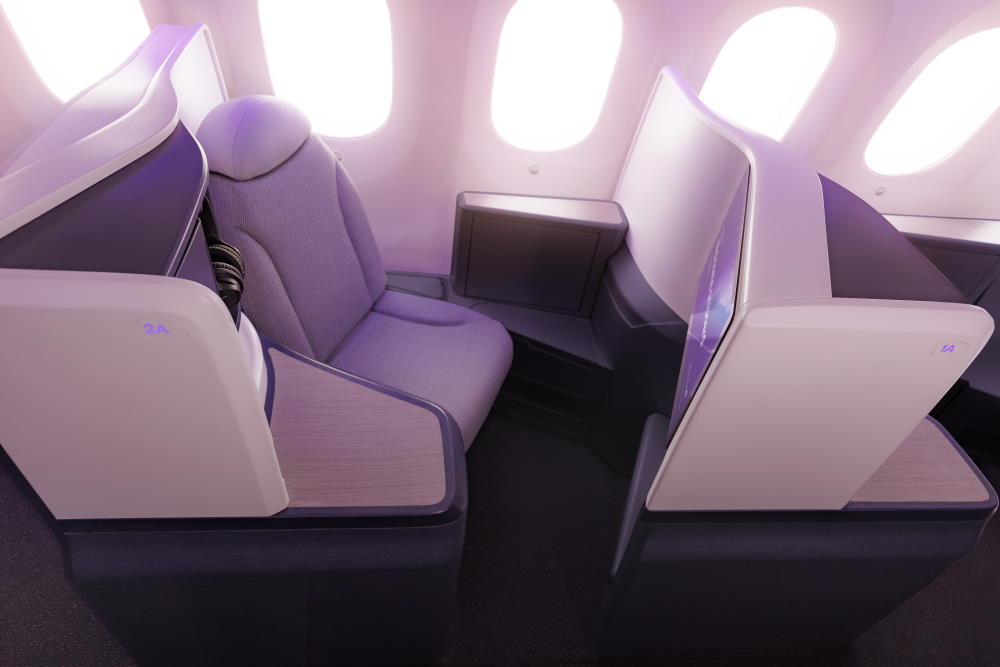
Photo: New Business Class seat render. Courtesy of Air New Zealand
The currently 14 active Boeing 787-9s of the airline will be retrofitted. The beds will be one of the longest in the sky, measuring 81″ (205 cm) in length—and the airline will join the trend of offering an upgraded product called Business Premier Luxe in the bulkhead rows, boasting 25% more living space and a sliding door.

